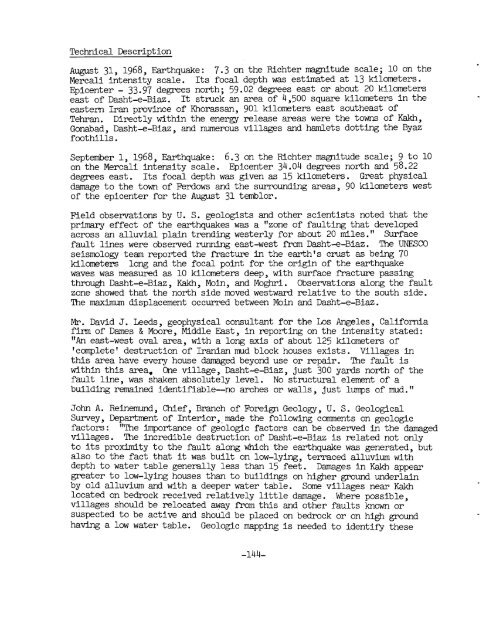3. - usaid
3. - usaid
3. - usaid
You also want an ePaper? Increase the reach of your titles
YUMPU automatically turns print PDFs into web optimized ePapers that Google loves.
Technical Description<br />
August 31, 1968, Earthquake : 7.3 on the Richter magnitude scale; 10 on the<br />
Mercali intensity scale. Its focal depth was estimated at 13 kilometers.<br />
Epicenter - 3<strong>3.</strong>97 degrees north; 59.02 degrees east or about 20 kilometers<br />
east of Dasht-e-Biaz . It struck an area of 4,500 square kilometers in the<br />
eastern Iran province of Khorassan, 901 kilometers east southeast of<br />
Tehran. Directly within the energy release areas were the towns of Kakh,<br />
Gonabad, Dasht-e-Biaz, and numerous villages and hamlets dotting the Byaz<br />
foothills.<br />
September 1, 1968, Earthquake: 6.3 on the Richter magnitude scale; 9 to 10<br />
on the Mercali intensity scale. Epicenter 34.04 degrees north and 58.22<br />
degrees east. Its focal depth was given as 15 kilometers. Great physical<br />
damage to the town of Ferdows and the surrounding areas, 90 kilometers west<br />
of the epicenter for the August 31 temblor.<br />
Field observations by U. S. geologists and other scientists noted that the<br />
primary effect of the earthquakes was a "zone of faulting that developed<br />
across an alluvial plain trending westerly for about 20 miles." Surface<br />
fault lines were observed running.east-west from Dasht-e-Biaz. The UNESCO<br />
seismology team reported the fracture in the earth's crust as being 70<br />
kilometers long and the focal point for the origin of the earthquake<br />
waves was measured as 10 kilometers deep, with surface fracture passing<br />
through Dasht-e-Biaz, Kakh, Moin, and Moghri. Observations along the fault<br />
zone showed that the north side moved westward relative to the south side.<br />
The maximum displacement occurred between Moin and Dasht-e-Biaz.<br />
Mr. David J. Leeds, geophysical consultant for the Los fkgeles, California<br />
firm of Dames & Moore, Middle East, in reporting on the intensity stated:<br />
"An east-west oval area, with a long axis of about 125 kilometers of<br />
'complete' destruction of Iranian mud block houses exists. Villages in<br />
this area have every house damaged beyond use or repair. The fault is<br />
within this area, One village, Dasht-e-Biaz, just 300 yards north of the<br />
fault line, was shaken absolutely level. No structural element of a<br />
building remained identifiable--no arches or walls, just lumps of mud."<br />
John A. Reinemund, Chief, Branch of Foreign Geology, U. S. Geological<br />
Survey, Department of Interior,,made the following comments on geologic<br />
factors: "The iqortance of geologic factors can be observed in the damaged<br />
villages. The incredible destruction of Dasht-e-Biaz is related not only<br />
to its proximity to the fault along which the earthquake was generated, but<br />
also to the fact that it was built on low-lying, terraced alluvium with<br />
depth to water table generally less than 15 feet. Damages in Kakh appear<br />
greater to low-lying houses than to buildings on higher ground underlain<br />
by old alluvium and with a deeper water table. Some villages near Kakh<br />
located on bedrock received relatively little damage. Where possible,<br />
villages should be relocated away from this and other faults known or<br />
suspected to be active and should be placed on bedrock or on hi@ ground<br />
having a low water table. Geologic mapping is needed to identify these
















